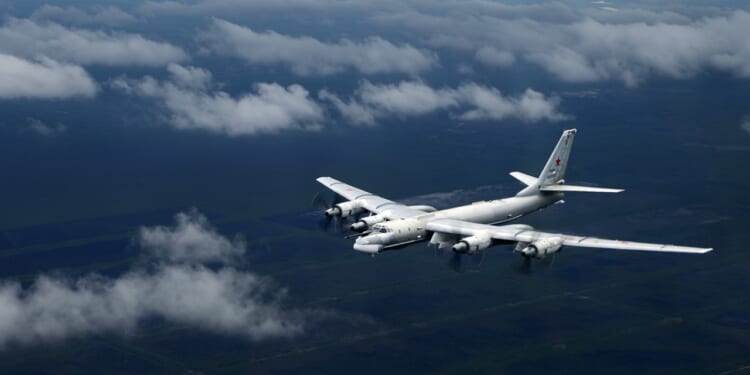Despite its age and shortcomings, the rugged and reliable Tu-95 “Bear” bomber is a symbol of national pride for Russia, and a recurring nuisance for NORAD.
Less than a week after NATO claimed it intercepted three Russian Aerospace Force’s Mikoyan MiG-31 (NATO reporting name “Foxhound”) fighter jets after the aircraft entered Estonian airspace, the North American Aerospace Defense Command (NORAD) announced that it “detected and tracked” a pair of Tupolev Tu-95 (NATO reporting name “Bear”) long-range strategic bombers and two Sukhoi Su-35 (NATO reporting name “Flanker M”) fighters “operating in the Alaska Air Defense Identification Zone (ADIZ)” on Wednesday.
The Russian bombers and fighters did not enter US or Canadian airspace. However, they were intercepted by four US Air Force F-16 Fighting Falcons, supported by a Boeing E-3 Sentry airborne early warning and control (AEW&C) aircraft and four KC-135 tankers. It is unclear why so many aerial refuelers were required, but the US warplanes positively identified and escorted the Russian aircraft while they remained in the ADIZ.
Entering ADIZ Zones Is an Old Cat-and-Mouse Game
Moscow has maintained that such patrol flights are routine, despite a sharp increase in recent years. It is part of the Kremlin’s efforts to demonstrate power and to test US defense responses as it asserts greater influence in the Arctic strategic region.
Washington has described the flights as an attempt to send a “deliberate geopolitical message,” while military analysts warn they could be a rehearsal for potential conflict.
It is important to note that the Russian aircraft regularly enter the ADIZ, which is the designated area of airspace over land or water where all aircraft are required to provide a ready identification, location, and control. According to the Federal Aviation Administration, aircraft that enter or operate within a country’s ADIZ typically “must comply with specific reporting procedures, including filing flight plans, using transponders, and making position reports, to ensure their timely identification by national authorities.”
As previously reported, Russia does not follow these steps when carrying out its “patrol” flights, which is why NORAD responds by scrambling combat aircraft. The Kremlin had carried out the flights in the ADIZ during the Cold War, but Moscow has steadily increased the number of flights in the region since 2014. The most recent such patrol sortie before Wednesday was in August.
In July 2024, Russia carried out a far less “routine sortie” when it conducted the first joint patrol with the Chinese People’s Liberation Army Air Force. Two Tu-95s were accompanied by a pair of Xi’an H-6 aircraft, the PLAAF’s primary strategic bomber. The H-6 is a license-built version of the Soviet-designed Tupolev Tu-16, and it has been in service since 1969.
The Russian Ministry of Defense confirmed on Thursday that the flight occurred, but did not acknowledge that it was within Alaska’s ADIZ.
“The Tu-95MS strategic missile-carrying bombers of long-range aviation of Russia’s Aerospace Forces performed a scheduled flight in the airspace over neutral waters of the Bering and Okhotsk Seas. The flight lasted over 14 hours,” the ministry said in a statement to Tass.
The Tu-95’s Specifications
- Year Introduced: 1956 (Tu-95), 1981 (Tu-95MS)
- Number Built: 88 Tu-95MS built between 1982 and 1992
- Length: 46.2 m (151 ft 7 in)
- Wingspan: 50.1 m (164 ft 4 in)
- Weight:
- 90,000 kg (198,416 lb) empty
- 188,000 kg (414,469 lb) MTOW
- Engines: Four Kuznetsov NK-12 turboprop engines (15,000 PS each)
- Top Speed: 920 km/h (572 mph), ~Mach 0.75
- Range: Over 15,000 km (9,300 mi)
- Service Ceiling: 13,716 m (45,000 ft)
- Loadout: Two 23mm cannons, Kh-55 cruise missiles; up to 15,000 kg (33,000 lb) payload capacity
- Aircrew: 6-7
Russia’s Tu-95 Bomber Is Old—but Still Dangerous
The deployment of the Tu-95 to the Alaskan ADIZ is also noteworthy, as it serves as a reminder that Russia remains the only operator of a propeller-driven bomber. Although the US Air Force Boeing B-52 Stratofortress is just as old, it is hard not to see the Tu-95 as far more antiquated, even as it has received significant upgrades.
The choice of propeller-driven engines was made during the Cold War, as its jet engines of the era burned through fuel far too quickly, and the Soviet Air Force lacked the capability to refuel its bombers in flight. It was among the few Soviet-era bombers capable of flying a distance of 5,000 miles and striking targets within the United States from territory within its own borders. The updated variants are reported to have a range exceeding 9,300 miles (15,000 km).
However, propeller engines have one notable and insurmountable drawback: they are extremely slow compared to jet engines. The Tu-95 was noted for being able to fly slowly and steadily to get the job done, at least at the time—but it is hard to imagine that any Tu-95s could penetrate modern air defenses. Indeed, the US Air Force F-16s that scrambled to intercept the Tu-95s had no problem catching up!
Another notable fact about the bomber is that, despite entering service 70 years ago, the Tu-95 was never actually employed in combat until 2015, when a pair of Tu-95s were used in a series of long-range airstrikes as part of the Russian military intervention in Syria.
Though the “Bear” moniker was initially employed by NATO, the Russian Air Force liked the nickname, and the Kremlin later adopted it as the aircraft’s official designation. Despite its age and shortcomings, the rugged and reliable bomber also became a symbol of pride for the Soviet Union, and was often demonstrated at European air shows. Even today, it remains the aircraft that most often tests America’s resolve along its northern border.
About the Author: Peter Suciu
Peter Suciu has contributed over 3,200 published pieces to more than four dozen magazines and websites over a 30-year career in journalism. He regularly writes about military hardware, firearms history, cybersecurity, politics, and international affairs. Peter is also a contributing writer for Forbes and Clearance Jobs. He is based in Michigan. You can follow him on Twitter: @PeterSuciu. You can email the author: [email protected].
Image: Shutterstock / Fasttailwind.

















